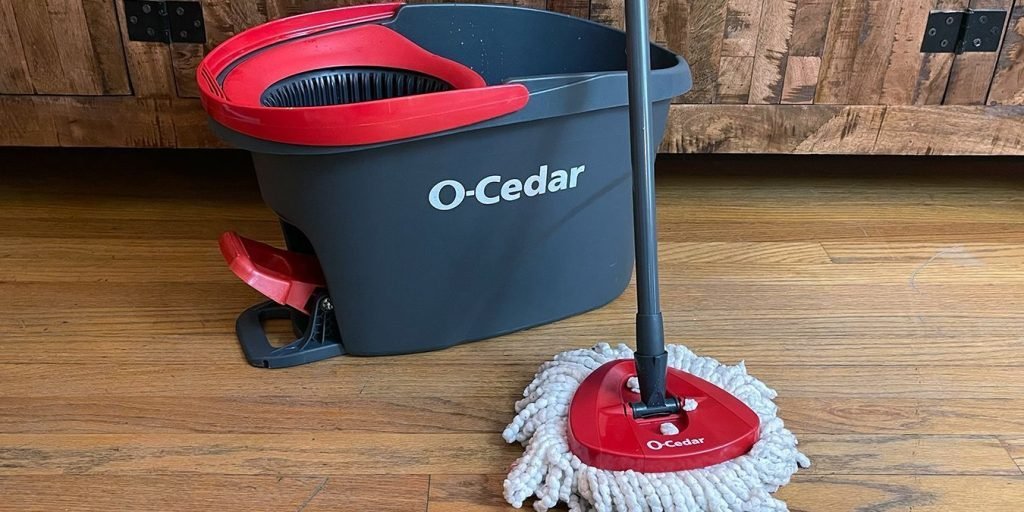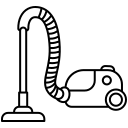How to Clean Mop Buckets

Most of the time, we are only concerned about getting the floor clean. Seldom do we ever think of the apparatus used to get that floor clean. In this case, we are referring to the mop bucket and the mop itself. In order to do a thorough cleaning job with your mop bucket, you have to ensure that it is clean.
So, how do you clean the mop bucket? The process of cleaning a mop bucket is very simple with the only things needed being bleach, a scouring sponge and clean water.
Keep reading to learn how to go about cleaning the mop bucket, ways in which to keep the mops smelling fresh, and the best way to mop your floors.
Cleaning the Bucket
We can all agree that mop buckets retain dirt, and as such, they should be cleaned regularly. The more often you clean your floors, the more dirt your mop bucket is likely to accumulate. Of course, mop buckets vary in sizes and even in the level of complexity in how they work, but they all serve the safe function, which is cleaning.
It is imperative to have a routine of disinfecting your mop bucket regularly, to get rid of dirt and bacteria that accumulates in it after each mopping. Below is a step-by-step guide on how to wash it.
# First, you have to protect yourself by putting on gloves. The dirty water stored in the bucket can leave a residue containing bacteria and other harmful contaminants not fit for handling with bare hands.
# Start by rinsing the mop thoroughly using warm water. You can do this in the bathroom shower.
# Put one gallon of water and one cup of bleach in the mop bucket. If you use a floor-washing solution, do not use the bleach. Instead, use hot water and vinegar. The point here is to avoid ammonia and bleach mixing because a combination of the two will produce exceedingly toxic gas.
# Let the bleach solution stay in the bucket for at least five minutes.
# You can then scrub the inner part of the bucket using a scouring sponge. Ensure that you wash all attachments and chambers using the bleach solution.
# Once you are sure the bucket is clean, rinse it with plain water and put it upside down to drain off the water.
You should disinfect the mop bucket on a weekly basis because it will always be in contact with dirt and contaminants. Additionally, do not store anything else in your mop bucket, not even your cleaning supplies, unless you are sure that it is clean. If you are planning to buy a mop, you can take a look at my reviews about spin mops. I feel these types of mops are quite useful and they help me to clean quickly.
Cleaning the Mop
You now have a clean mop bucket. What about the mop? It does not matter how clean the mop bucket is, if the mop itself is dirty, then the surface you are leaning will never be sparkling clean. Bacteria and other germs thrive on a dirty mop, the more reason to keep your mop clean. In fact, you may never see the need for replacing your mop head if you clean and maintain it well. It is advisable to clean it after every use. Below is an extensive guide on how to clean the mops.
#1 Soak and rinse
#2 The items needed include rubber gloves like this, water, bleach, bucket, liquid dish soap.
#3 As always, protect your hands by putting on gloves. Start by rinsing the mop in some clean warm water. Using your hands, pull out the large pieces of debris from the mop head as you rinse it.
#4 In another bucket, mix some hot water with a sterilizing agent such as bleach. For each gallon of hot water, add one teaspoon of bleach. Immerse the mop head-down in the mixture and leave it for at least 20 minutes.
#5 Remove it from the bleach solution and rinse it in water with liquid dish soap. The liquid dish soap ensures it is free of the cleaner used so that it does not react with your floor cleaners later. Hang it upright and let it dry off completely before placing it in its storage area.
Note that you should not soak the mop for too long as the warmth and moisture will form a breeding zone for bacteria and mold. Additionally, when you soak it in bleach, place it in a safe place away from children’s reach.
# In A Dishwasher
If the mop has a removable head, you can wash it in the dishwasher. Ensure that the dishwasher is empty before placing the mop head on the top rack. Add a cup of vinegar in the detergent dispenser. Turn on the dishwasher and let it run the normal cycle. When done, squeeze out the dripping water by hand and hang it to dry. Just like that, you have a clean mop to use in your clean bucket.
# In the Washing Machine
Just like the dishwasher, you can also clean a removable mop head in the washer, with the exception of sponge mop heads. Add a little bleach in the machine and put the mop head in the washer. Let it run alone on a normal cycle, after which you can manually squeeze out t.e excess water before letting it dry in sun.
For a dry mop, first, you need to shake off as much dirt as you can before proceeding with any of the above methods.
How Do You Get the Sour Smell Out Of Mops?
After mopping, most people leave the mop inside the mop bucket or store it in some dark corner when it is still wet. This will definitely get your mop stinking and if you use it as it is, you will have the entire house smelling bad. So, what do you do to remove this sour smell?
# Kill the Smell Using Chlorine
Chlorine is a number one household disinfectant that has been proven to work. Mix a cup of it in three gallons of hot water and immerse your mop head for around 15 minutes. Let the solution circulate through the strings. Hang it outside or in a dry location with sufficient air circulation to allow it to dry. Once your mop is free of the pungent smell, you do not want it to reoccur. To prevent this, ensure that you always hang your mop. Additionally, do not rest the strings on the ground for long, as this will form moisture from underneath.
# Chorine Alternatives
If you do not have bleach, or maybe you are avoiding it because of its strong smell and corrosive nature, you can go for further options. Baking soda or vinegar will also do a great job of eliminating the sour smell. Just make sure that regardless of the solution you use, you must let the strings dry out every time you use the mop to prevent bacteria from coming back.
How Do You Mop the Floor?
You now have a clean mop bucket and mop. You are all set to clean the floor. The question is, do you know how to mop the floor properly? Most people may assume that they know how to do ‘this. After all, they have been doing it for long. When mopping, most people make the mistake of using the same wash water for rinsing as well. You should have two mop buckets. One is for washing and the other one should contain the rinse water. Here is a guide to floor cleaning.
Supplies needed: vacuum cleaner or broom and a dustpan, sponge, cleaner, two mop buckets, mopping detergent and a mop.
# Choose a mop and buckets – the kind of mop to use depends on the type of flooring. For floors with a lot of texture such as certain ceramics, a strip mop or a more classic string mop will do. For smooth floors, you can use a sponge mop like this. If you are using a strip or string mop, a mop buck with built-n wringers would be ideal. For a sponge mob, use any bucket with a handle.
# Choose a cleaner – choose a detergent ideal for your floor based on the manufacturer’s specifications.
# Vacuum or sweep first – before to begin to mop, you need to vacuum or sweep so that the floor does not become stick or muddy when you introduce water. At this stage, you will notice sticky and gunky spots, which you will pre-wash with some soapy water and a sponge.
# Fill the mop buckets – fill both buckets with hot water. Hot water cleans quicker and better compared to just lukewarm or cold water. Add some mopping detergent in the wash bucket. Resist the temptation of putting excess detergent in a bid to boost cleaning power. In any case, it will only make the rinsing harder.
# Dip and wring the mop – dip the mop in the wash bucket and wring it by hand or with a wringer. You only need it damp and not sopping wet. Too much water will extend the drying time.
# Start mopping – mop the floor from end to end. If you are using a sponge mop, mop in a straight line. For rag mops, use the figure 8 motion so that you utilize it effectively.
# Clear stubborn stain – rub rapidly over any stain you encounter to ensure you are not leaving behind any dirt.
# Rinse the mopped area – after washing every small portion, rinse the mop thoroughly in the rinse bucket and rinse the part of the floor already covered. Remove as much water as possible so that the floor can dry out quickly.
# Continue mopping – proceed with mopping until the entire floor is cleaned up well. Ensure that you do not leave behind any tracks.
Once done, wash your mop and rinse it properly before letting it dry. Your mop bucket should also be well taken care of. Ensure to wash it at least once per week.
Related Questions
How often should the floors be mopped?
Cleaning the floors is a never-ending process because dirt will always find its way in. High traffic areas need frequent mopping. However, you can mop areas that are less used at least once per week.
What can you use to mop the floors?
You can use a variety of products on to mop the floors. For instance, you can use homemade cleaners such as vinegar or mild is soap, or you can get store-bought cleaners. Just ensure to use as little detergent as possible to avoid damaging the floor.








